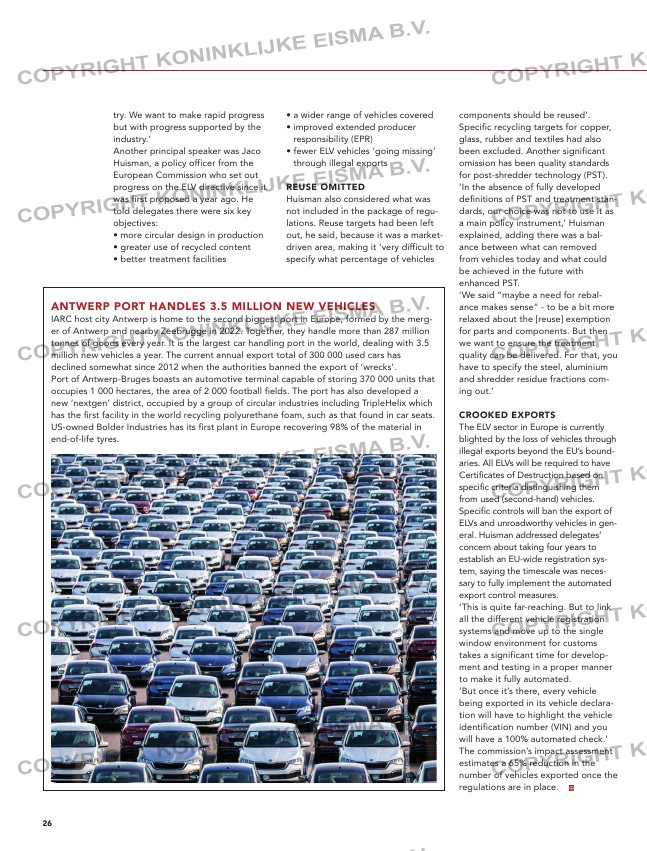Page 26 from: What’s inside issue #4?

26
ANTWERP PORT HANDLES 3.5 MILLION NEW VEHICLES
IARC host city Antwerp is home to the second biggest port in Europe, formed by the merg-
er of Antwerp and nearby Zeebrugge in 2022. Together, they handle more than 287 million
tonnes of goods every year. It is the largest car handling port in the world, dealing with 3.5
million new vehicles a year. The current annual export total of 300 000 used cars has
declined somewhat since 2012 when the authorities banned the export of ‘wrecks’.
Port of Antwerp-Bruges boasts an automotive terminal capable of storing 370 000 units that
occupies 1 000 hectares, the area of 2 000 football fields. The port has also developed a
new ‘nextgen’ district, occupied by a group of circular industries including TripleHelix which
has the first facility in the world recycling polyurethane foam, such as that found in car seats.
US-owned Bolder Industries has its first plant in Europe recovering 98% of the material in
end-of-life tyres.
components should be reused’.
Specific recycling targets for copper,
glass, rubber and textiles had also
been excluded. Another significant
omission has been quality standards
for post-shredder technology (PST).
‘In the absence of fully developed
definitions of PST and treatment stan-
dards, our choice was not to use it as
a main policy instrument,’ Huisman
explained, adding there was a bal-
ance between what can removed
from vehicles today and what could
be achieved in the future with
enhanced PST.
‘We said “maybe a need for rebal-
ance makes sense” – to be a bit more
relaxed about the [reuse] exemption
for parts and components. But then
we want to ensure the treatment
quality can be delivered. For that, you
have to specify the steel, aluminium
and shredder residue fractions com-
ing out.’
CROOKED EXPORTS
The ELV sector in Europe is currently
blighted by the loss of vehicles through
illegal exports beyond the EU’s bound-
aries. All ELVs will be required to have
Certificates of Destruction based on
specific criteria distinguishing them
from used (second-hand) vehicles.
Specific controls will ban the export of
ELVs and unroadworthy vehicles in gen-
eral. Huisman addressed delegates’
concern about taking four years to
establish an EU-wide registration sys-
tem, saying the timescale was neces-
sary to fully implement the automated
export control measures.
‘This is quite far-reaching. But to link
all the different vehicle registration
systems and move up to the single
window environment for customs
takes a significant time for develop-
ment and testing in a proper manner
to make it fully automated.
‘But once it’s there, every vehicle
being exported in its vehicle declara-
tion will have to highlight the vehicle
identification number (VIN) and you
will have a 100% automated check.’
The commission’s impact assessment
estimates a 65% reduction in the
number of vehicles exported once the
regulations are in place.
• a wider range of vehicles covered
• improved extended producer
responsibility (EPR)
• fewer ELV vehicles ‘going missing’
through illegal exports
REUSE OMITTED
Huisman also considered what was
not included in the package of regu-
lations. Reuse targets had been left
out, he said, because it was a market-
driven area, making it ‘very difficult to
specify what percentage of vehicles
try. We want to make rapid progress
but with progress supported by the
industry.’
Another principal speaker was Jaco
Huisman, a policy officer from the
European Commission who set out
progress on the ELV directive since it
was first proposed a year ago. He
told delegates there were six key
objectives:
• more circular design in production
• greater use of recycled content
• better treatment facilities
24-25-26_iarcpart1.indd 26 03-07-2024 10:08



